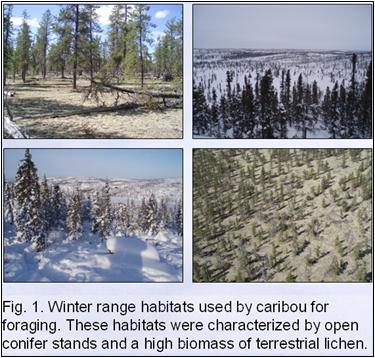Summary
This project is investigating the habitat ecology and distribution of Bathurst caribou relative to the interactions of climate change, fire, snow conditions, and the density of caribou on the winter range. Species-distribution models are an effective tool for monitoring and mapping patterns of habitat use, and show promise for conservation of animals with variable life histories. We used environmental variables to predict the occurrence of Bathurst caribou across both early and late winter range.
• We used a Resource Selection Function (RSF) to scale the observed distribution of caribou to the relative probability of selecting a habitat patch.
• First, we developed a set of candidate models to investigate factors that might influence caribou distribution during winter: snow depth, patch age and vegetation type, distance to small and large fires, and distance to water.
• We used an information-theoretic approach called Akaike Information Criterion (AIC) to select the best model from the set of candidates and applied this global model to both the early and late winter caribou locations.
• We used matched logistic regression to test for selection or avoidance of habitats, and k-fold cross validation to evaluatemodel performance.

Results
- Snow depth, patch age, vegetation type, distance to fire and water, and quadratic terms for distance variables best predicted the distribution of Bathurst caribou.
- All models displayed good to excellent predictive capabilities of caribou occurrence.
- The models simulating seasonal distributions of caribou reveal some significant temporal differences in habitat use during winter.
- Caribou appeared more selective during late winter, and favored older, lichen-rich patches farther from large fires and closer to water.
- Results suggested that caribou may be most sensitive to the short-term effects of wild fire during late winter.
- In late winter, caribou are more likely to occupy a lichen habitat at distances closer to small burns and farther from large burns.
- The models were useful for exploring factors that may limit or influence the distribution of Bathurst caribou on the winter range.
- Future analyses will explore additional variables, such as predation risk and road disturbance.
Application
Considering the recent decline of the Bathurst herd of barren-ground caribou, these models can help direct management strategies by revealing important resources that may affect the persistence of the population (Fig. 1). Knowledge of the short- and long-term effects of wild land fire on caribou distributions are vital for future policy and planning.
Contacts
Tara Barrier, Graduate Student
Ecosystem Science & Management Program
University of Northern British Columbia
3333 University Way
Prince George, B.C.
V2N 4Z9
ebyrulz 'at' gmail.com
Chris Johnson, Assistant Professor
Ecosystem Science & Management Program
University of Northern British Columbia
3333 University Way
Prince George, B.C.
V2N 4Z9
Phone: (250) 960-5357
johnsoch 'at' unbc.ca

